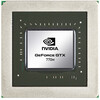Review Gigabyte P25W Notebook
Intel Core i7-4700MQ | NVIDIA GeForce GTX 770M | 15.60" | 2.9 kg

The NVIDIA GeForce GTX 770M is a high-end DirectX 11-compatible graphics card for laptops. It is based on the Kepler GK106 chip, as the older GTX 670MX, but offers a higher core and memory clock rate and GPU Boost 2.0. The feature set is still identical.
As a novelty, the GeForce 700M series implements GPU Boost 2.0 to automatically overclock the core clock rate. Depending on the cooling headroom of the laptop and the application / game, up to 15 % performance gains are possible.
Architecture
The Kepler architecture is the successor to the Fermi architecture that first appeared in laptops with the GeForce 400M series. The GK106 Kepler core offers five shader blocks, called SMX, that are clocked at the same speed as the central core. In the GTX 770M, all five blocks are active for a total of 960 CUDA cores. Although the Kepler architecture can utilize more shader cores than a Fermi chip, its shaders can be up to twice as power efficient. However, due to the missing hot clock of the shader domain, two shaders of a Kepler chip are of similar speed to one shader of a Fermi chip (as the latter is clocked twice as fast).
PCIe 3.0 is now supported by the mobile Kepler series and an optional Turbo mode can automatically overclock the Nvidia card by a theoretical 15 percent if the laptop cooling system allows it. The implementation of this boost mode is done in the BIOS, but it is ultimately dependent upon the manufacturer of the laptop.
Performance
The graphics performance of the GeForce GTX 770M is situated between the old GTX 675MX and 680M high-end graphics cards. The maximum performance may differ a bit depending on the cooling solution of the used laptop (due to GPU Boost 2.0 better colling solutions lead to a better performance). Very demanding games of 2013 like Crysis 3 or Far Cry 3 may need more performance for 1920x1080 and maximum detail settings. Therefore, 1600x900 without antialiasing may be the maximum setting for these games. Older and less demanding games however are playable in full HD and ultra settings. See below for detail gaming benchmarks.
Features
The feature set of the GTX770M is identical to the GTX670MX as both are based on the same GK106 core. Therefore the GPU supports up to 4 active displays. Furthermore, high resolution monitors of up to 3840x2160 pixels can now be connected using DisplayPort 1.2 or HDMI 1.4a if available. HD-Audio codecs, such as Dolby TrueHD and DTS-HD, can be transmitted via bitstream mode through the HDMI port. However, as most laptops will feature Optimus, the integrated GPU will likely have direct control over the display ports and may limit the feature set available by the Nvidia Kepler cards.
The 5th generation PureVideo HD video processor (VP5) is also integrated in the GK104 core and offers hardware decoding of HD videos. Common codecs such as MPEG-1/2, MPEG-4 ASP, H.264 and VC1/WMV9 are fully supported up to 4K resolutions while VC1 and MPEG-4 are supported up to 1080p. Two streams can be decoded in parallel for features such as Picture-in-Picture. Finally, the dedicated video encoding engine called NVENC API similar to Intel QuickSync is integrated in the chip.
The power consumption of the GeForce GTX 770M should be similar to the GTX 670MX (75 Watt according to rumors) and is therefore best suited for large notebooks (17-inches or greater) and desktop replacements.
GeForce GTX 700M Series
| |||||||||||||||||||||||||
| Codename | N14E-GS | ||||||||||||||||||||||||
| Architecture | Kepler | ||||||||||||||||||||||||
| Pipelines | 960 - unified | ||||||||||||||||||||||||
| Core Speed | 811 MHz | ||||||||||||||||||||||||
| Memory Speed | 4000 MHz | ||||||||||||||||||||||||
| Memory Bus Width | 192 Bit | ||||||||||||||||||||||||
| Memory Type | GDDR5 | ||||||||||||||||||||||||
| Max. Amount of Memory | 3 GB | ||||||||||||||||||||||||
| Shared Memory | no | ||||||||||||||||||||||||
| API | DirectX 11, Shader 5.0, OpenGL 4.3 | ||||||||||||||||||||||||
| Power Consumption | 50-55 Watt | ||||||||||||||||||||||||
| Transistor Count | 3.5 Billion | ||||||||||||||||||||||||
| technology | 28 nm | ||||||||||||||||||||||||
| Features | Optimus, SLI, PhysX, Verde Drivers, CUDA, 3D Vision, 3DTV Play | ||||||||||||||||||||||||
| Notebook Size | large | ||||||||||||||||||||||||
| Date of Announcement | 30.05.2013 | ||||||||||||||||||||||||
The following benchmarks stem from our benchmarks of review laptops. The performance depends on the used graphics memory, clock rate, processor, system settings, drivers, and operating systems. So the results don't have to be representative for all laptops with this GPU. For detailed information on the benchmark results, click on the fps number.
















































For more games that might be playable and a list of all games and graphics cards visit our Gaming List
Asus G750JX: Intel Core i7-4700HQ, 17.30", 4.1 kg
Review » Preview Asus G750JX Notebook
One K73-3N: Intel Core i7-4800MQ, 17.30", 3.7 kg
Review » Review One K73-3N (Clevo P170SM) Notebook
Toshiba Qosmio X75-A7295: Intel Core i7-4700MQ, 17.30", 3.4 kg
External Review » Toshiba Qosmio X75-A7295
Digital Storm Krypton 17 inch: Intel Core i7-4700MQ, 17.30", 3.9 kg
External Review » Digital Storm Krypton 17 inch
Cyberpower Fangbook EVO HX7-150: Intel Core i7-4700MQ, 17.30", 3.9 kg
External Review » Cyberpower Fangbook EVO HX7-150
Toshiba Qosmio X70-A-114: Intel Core i7-4700MQ, 17.30", 3.6 kg
External Review » Toshiba Qosmio X70-A-114
MSI GT70 2OC-065US: Intel Core i7-4700MQ, 17.30", 3.8 kg
External Review » MSI GT70 2OC-065US
Toshiba Qosmio X70-A-12W: Intel Core i7-4700MQ, 17.30", 3.4 kg
External Review » Toshiba Qosmio X70-A-12W
Toshiba Qosmio X70-A-122: Intel Core i7-4700MQ, 17.30", 3.4 kg
External Review » Toshiba Qosmio X70-A-122
Toshiba Qosmio X70-A-10F: Intel Core i7-4700MQ, 17.30", 3.3 kg
External Review » Toshiba Qosmio X70-A-10F
Gigabyte P25W: Intel Core i7-4700MQ, 15.60", 2.9 kg
External Review » Gigabyte P25W
Alienware 17: Intel Core i7-4800MQ, 17.30", 4.2 kg
External Review » Alienware 17
Asus G750JX-T4070H: Intel Core i7-4700HQ, 17.30", 4.5 kg
External Review » Asus G750JX-T4070H
Toshiba Qosmio X75-A7298: Intel Core i7-4700MQ, 17.30", 3.4 kg
External Review » Toshiba Qosmio X75-A7298
Toshiba Qosmio X70-AST2GX1: Intel Core i7-4700MQ, 17.30", 3.5 kg
External Review » Toshiba Qosmio X70-AST2GX1
Asus G750JX-DB71: Intel Core i7-4700HQ, 17.30", 4.5 kg
External Review » Asus G750JX-DB71
Asus G750JX-T4045H: Intel Core i7-4700HQ, 17.30", 4.5 kg
External Review » Asus G750JX-T4045H
Asus G750JX-T4052H: Intel Core i7-4700HQ, 17.30", 4 kg
External Review » Asus G750JX-T4052H
Asus G750JX: Intel Core i7-4700HQ, 17.30", 4.1 kg
External Review » Asus G750JX
Medion Erazer X7825-MD98416: Intel Core i7-4700MQ, 17.30", 3.9 kg
External Review » Medion Erazer X7825-MD98416
» Comparison of GPUs
Detailed list of all laptop GPUs sorted by class and performance.
» Benchmark List
Sort and restrict laptop GPUs based on performance in synthetic benchmarks.
» Notebook Gaming List
Playable games for each graphics card and their average FPS results.
Top 10 Laptops
Multimedia, Budget Multimedia, Gaming, Budget Gaming, Lightweight Gaming, Business, Budget Office, Workstation, Subnotebooks, Ultrabooks, Chromebooks
under 300 USD/Euros, under 500 USD/Euros, 1,000 USD/Euros, for University Students, Best Displays
Top 10 Smartphones
Smartphones, Phablets, ≤6-inch, Camera Smartphones